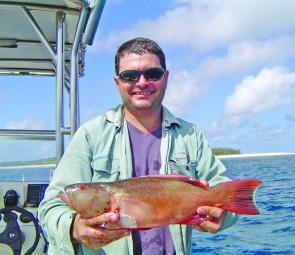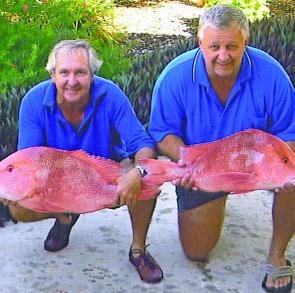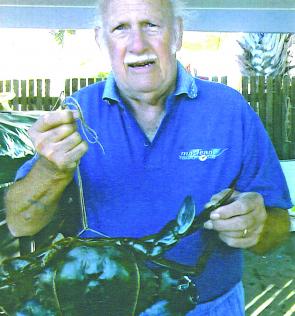July is a great time to be on the water in Gladstone. While it cools down at night somewhat, the days are usually sunny with the winds generally lighter and more stable. Afternoon instabilities are less likely to spoil a day on your favourite reef.
This is also the month when boating, fishing and camping should feature in planned trips. This month we are headed to the top end of Curtis Island to check out the beaches of Cape Keppel for a camping trip. With the seasonal prevailing winds from the southeast this is a protected location, and with plenty of sandy beaches, it is a great spot to anchor up overnight.
Graham Creek is fishing and crabbing well. Some huge buck mud crabs are finding their way into pots. The best location is where a mangrove drain bleeds into a mud bank. Fish frames are all that’s required to entice a monster.
Queenfish and threadfin salmon are also appearing in a few reports from Graham Creek. There are also reports of some good catches in The Narrows. This would be the time of year to hunt for salmon along The Narrows, particularly around Ramsays Crossing area.
Some thumper bream are hitting lines around Black Swan Island. Black Swan Creek is a tidal tributary that dries on the low but bristles with fish on the flooding tide. The edges of sandbars, particularly if they are gravelled, entice trevally and salmon to the area.
Macca and I had a trip to Rock Cod Shoals and after bouncing about for a couple of hours to get to the shoals and sitting in some very heavy swell, we decided to head in and try the more protected waters at the northern end of Facing Island.
This end of Facing Island is sheltered from the prevailing south easterlies and is a popular trolling location. The lighthouse here highlights the large rock groins which reach out from the island. Depth here varies from 15m to 20m. As we trolled and kept our eyes on the rocks, Macca picked up a spotty mackerel. It was a strong fighting fish but just 2cm short of the required 55cm.
Trips out to Wilson and Wreck islands have been productive for those boats capable of going out. These islands are 50nm from Gladstone so these trips are limited to the bigger boats. However, the red emperor capital of Queensland can be found around these islands, so if you can get out, it is usually worth it.
The wrecks around Gladstone come alive at night around this time of the year and red jew can be pulled in here. Mick and Joan Field had a recent trip to the wrecks off Cape Capricorn. They caught cobia, nannygai and jew, using cuttlefish, pilchards and squid to entice them to the hook.
While it is possible to catch a feed during the day, the winter’s stable weather conditions enable you to anchor easily at night. All Gladstone wrecks are relatively small so you need a good GPS and sounder to locate them.
I enjoyed a recent trip to Masthead as a guest of Ian and Sam Briggs on their 7.2m Haines Signature walkaround centre cab. It is a fabulous boat that easily handled the bounce of the trip out. It powered us out to Masthead and, as I am seldom a passenger, I sat back and enjoyed the trip in comfort.
The trip to Masthead crosses over several green zones, in particular Polmaise Reef. This was a favourite fishing location of mine before being closed. Whether the closure has made any difference to fish stocks is open to conjecture. I’m all in favour of seasonal or temporary closures of fishing hot spots, perhaps on a rotating basis, but I haven’t seen any research to convince me that permanent closures are the best solution.
Masthead Island is the second largest of the nine coral cays in the Capricorn group of islands and reefs at the southern end of the Great Barrier Reef. The island is a major nesting area for turtles and birds.
Camping is permitted at most times of the year, except regeneration periods. However, there are no facilities, and bookings and permits are required from QPWS.
I have not been ashore at Masthead yet as a line of fringing coral rims the beach area and I am not sure how to bring my boat into the beach without damaging the fibreglass hull. There must be a way, so watch this spot for future reports when I find out how it is done.
Briggsie anchored just offshore on the northwestern shelf, which was leeward of the strong south easterlies hitting the coast on this trip. The beauty of fishing close in the Masthead Island is that you are in 10-15m of crystal clear water and you can see the patches of reef to target.
Conditions weren’t great, but the walkabout features of Briggsie’s boat made fishing a breeze. The three of us raced around the deck targeting specific patches of reef – all without getting in each other’s way. On this day it was easy to see the flashes of colour scooting around under the boat.
This area is teeming with quality reef fish – and plenty of little ones too. We brought our share of stripies and collared sea bream to the boat before hooking onto some good coral trout.
Even without these great catches, fishing around a tropical island with pristine white beaches is sometimes its own reward.
Reads: 6058
Rob Plumridge brought this XXL cod to the boat while fishing the reefs around Gatcombe Heads.

Briggsie was pleased to pull a couple of these coral trout from the western side of Masthead Island (in the background).

Joan grabbed these two quality jew on a night expedition to one of Gladstone’s wrecks, north of Cape Capricorn.

Pat and Chris show off two red emperors caught at Wilson Island.

Reg enticed this lump of a Graham Creek mud crab into his pot with a fish frame.




